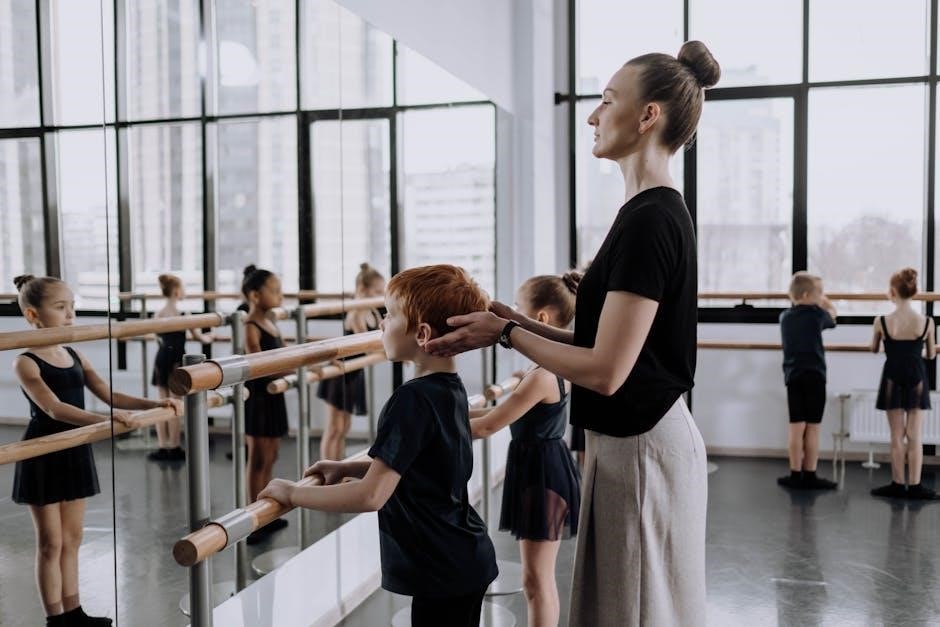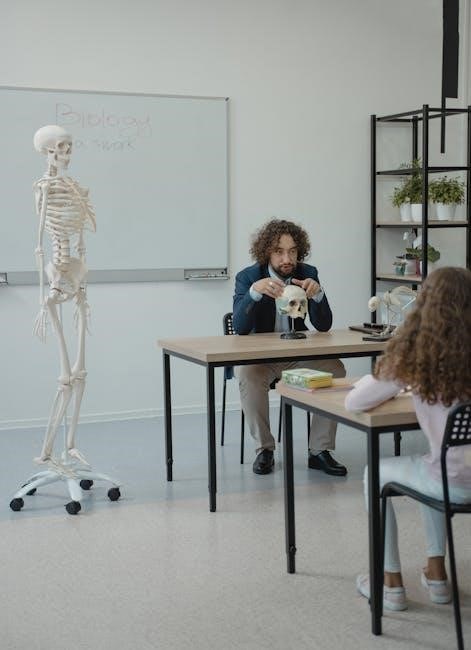Pointillism is an art technique using tiny dots to create images. Inspired by Georges Seurat and Paul Signac, it relies on optical mixing for color blending.
What is Pointillism?
Pointillism is a painting technique where small, distinct dots of color are applied in patterns to form an image. This method, pioneered by Georges Seurat and Paul Signac, relies on optical mixing, where colors blend in the viewer’s eye rather than on the canvas. By carefully placing dots of primary and secondary hues, artists achieve vivid, detailed compositions. The technique emphasizes scientific color theory and creates a sense of luminosity and texture. It challenges students to think critically about color relationships and visual perception.

History and Key Artists
Pointillism emerged in the late 19th century as a revolutionary art movement. Georges Seurat, often called the founder, pioneered the technique with works like A Sunday Afternoon on the La Grande Jatte. Paul Signac, another key figure, expanded its use, creating vibrant landscapes. The movement was part of Neo-Impressionism, emphasizing scientific color theory and optical mixing. These artists sought to break away from traditional methods, inspiring a new wave of modern art. Their innovative approach continues to influence artists and educators, making Pointillism a cornerstone of art history.
Materials Needed for the Class
Essentials include watercolor paper, Q-tips, primary color paints, masking tape, and paintbrushes. Optional: sticker dots for younger students to simplify the dotting process creatively.
Essential Art Supplies
The core supplies for a pointillism class include watercolor paper, Q-tips or cotton swabs, primary color paints, masking tape, and paintbrushes for base coats. A palette or plate for mixing colors and water cups are also necessary. For younger students, sticker dots in primary colors can simplify the process. These materials allow students to explore the technique of applying small dots to create detailed, optically mixed images, fostering creativity and understanding of color theory. Ensure all supplies are easily accessible to maintain a smooth workflow during the lesson.
Alternative Materials for Younger Students
For younger students, consider using sticker dots in primary colors, which eliminate the need for paint and brushes. Construction paper or pre-printed templates can serve as the base. Bingo markers or small stampers are also great for creating dots. Additionally, glue with a toothpick for applying small droplets can mimic the pointillism effect. These materials simplify the process while maintaining the core concept, making it accessible and engaging for younger learners. They also reduce mess and allow students to focus on the artistic technique and color theory fundamentals.

Teacher’s Step-by-Step Instructions
Introduce the pointillism technique, demonstrate dotting with Q-tips, and guide students in creating landscapes inspired by George Seurat. Emphasize primary colors and layering for vibrant results.
Preparation and Setup
Gather materials: watercolor paper, Q-tips, primary color paints, and masking tape. Prepare sketches of landscapes with foreground, middleground, and background. Arrange supplies at each workstation. Display examples of pointillist art for inspiration. Ensure students have access to water and paper towels. Use masking tape to secure paper on tables. Introduce the lesson with a slideshow on Georges Seurat to spark curiosity. Encourage students to ask questions and share observations. Provide a demonstration of the pointillism technique using Q-tips to create dots. Circulate around the room to assist and guide students as needed.
Demonstrating the Pointillism Technique
Guiding Students Through the Painting Process

Teaching the Color Theory Behind Pointillism
Introduce primary and secondary colors, explaining how they mix optically when applied as dots. Demonstrate how placing primary colors side by side creates secondary hues, enhancing the visual effect.
Primary and Secondary Colors
Begin by explaining primary colors (red, blue, yellow) as the foundation of color theory; Discuss how these cannot be created by mixing other colors. Introduce secondary colors (orange, green, purple) as mixtures of two primaries. Emphasize how pointillism uses these basics to create vibrant effects. Show examples of Seurat’s work to illustrate how dots of primary colors blend optically to form secondary hues. This foundational understanding helps students grasp the technique’s reliance on color interaction and optical mixing.
Optical Mixing and Color Blending
Explain how optical mixing works: when tiny dots of color are placed side by side, the viewer’s eye blends them into a new shade. Demonstrate this by applying small dots of primary colors to create secondary hues. Use a color wheel to show how warm and cool tones interact. Discuss how pointillism relies on this principle to achieve vibrant, layered effects. Have students experiment with blending colors using Q-tips or brushes, observing how distance enhances the blending effect. This hands-on approach helps students grasp the technique’s unique visual impact.
Engaging Students with Pointillism
Engage students by showcasing Seurat’s works, fostering curiosity and creativity. Encourage participation through interactive activities, group discussions, and hands-on projects that bring pointillism to life.
Showing Examples of Pointillist Art
Display iconic works like Georges Seurat’s A Sunday Afternoon on the Island of La Grande Jatte and Paul Signac’s Bathers at Asnières. These pieces showcase how tiny dots create detailed, vibrant scenes. Zoom in digitally or use magnifying glasses to highlight the dot technique. Discuss how colors blend optically, creating a sense of movement and light. This visual introduction sparks curiosity and helps students connect theory with practice, inspiring their own creative interpretations of pointillism.
Encouraging Student Participation and Questions
Foster engagement by inviting students to share their observations and thoughts about pointillist art. Encourage questions and discussions about the technique, colors, and compositions. Use open-ended prompts like, “What do you notice about how the dots create images?” or “How do the colors seem to mix?” Create a non-judgmental space where curiosity is celebrated. Consider pairing students for think-pair-share activities or hosting small group discussions to deepen understanding and excitement for the art form.
Classroom Management Tips
Organize workspaces neatly and supervise students to ensure safety with materials. Encourage focus and engagement, demonstrating patience and providing individualized support when needed.

Organizing the Workspace
Arrange tables and chairs to allow easy movement and visibility. Use containers or trays to store paints, Q-tips, and paper. Label materials for quick access. Designate areas for drying paintings and displaying examples. Ensure supplies are within reach for all students. Clear clutter to minimize distractions. Consider using masking tape to create borders for young students. This setup promotes efficiency and focus, allowing students to concentrate on their pointillism techniques. A well-organized workspace fosters creativity and ensures a smooth learning experience for everyone.
Supervising and Assisting Students
Monitor students as they work, circulating the room to offer guidance and answer questions. Provide individual support, especially for younger or less experienced students. Encourage proper technique, such as applying dots evenly and using primary colors effectively. Demonstrate patience and positivity, celebrating small successes. For those struggling, offer one-on-one assistance or modify the activity. Use visual aids like completed examples to clarify expectations. Ensure safety by reminding students to handle materials carefully. By actively supervising, you create a supportive environment that fosters creativity and learning while maintaining classroom order.
Assessment and Feedback
Evaluate students’ understanding through observation and completed projects. Provide constructive feedback on technique, color use, and creativity. Use formative assessments to guide individual progress and adapt instruction.
Evaluating Student Understanding
Evaluate students’ grasp of pointillism by observing their participation and completed projects. Assess their ability to apply the technique, mix colors, and create depth. Review their use of dots for detail and texture. Check if they can explain the optical mixing concept. Use formative assessments during painting sessions to guide progress. Review final artworks for understanding of color theory and technique. Provide feedback on creativity and adherence to the pointillism method. Ensure students can connect their work to the style of Seurat and Signac, demonstrating comprehension.
Providing Constructive Feedback
Offer constructive feedback to guide students in refining their pointillism techniques. Praise their use of color mixing and dots for creating depth. Highlight successful blending of primary colors. Encourage experimenting with dot sizes and spacing for texture. Provide specific suggestions, like refining dot placement or exploring contrast. Ensure feedback is positive and actionable, linking to Seurat and Signac’s methods. This helps students improve their optical illusions and artistic expression.

Leave a Reply